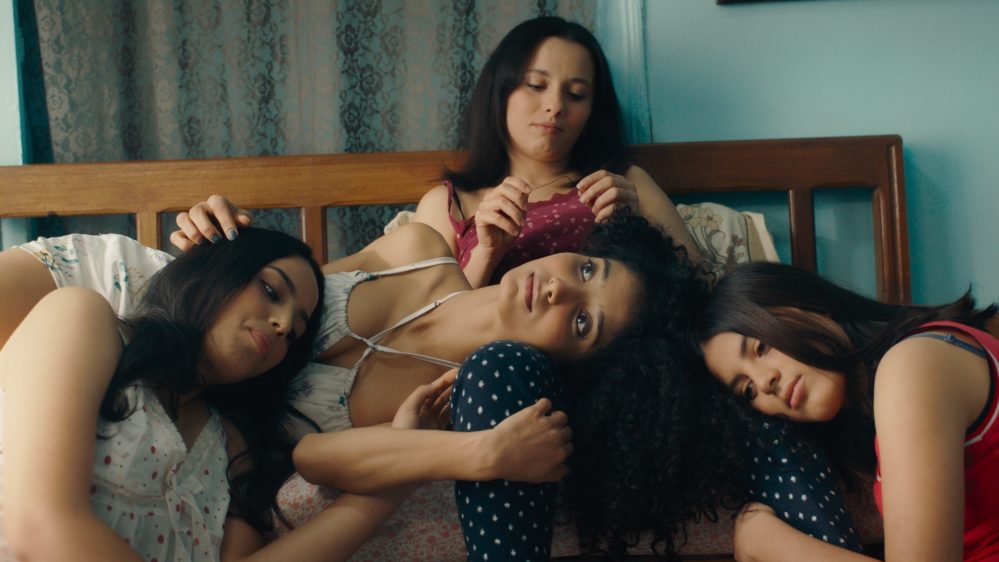
Late on in Kaouther Ben Hania’s compelling, ambitious hybrid “Four Daughters,” Olfa Hamrouni — the film’s focus, its fixation and its most charismatically contradictory character — strokes a purring, heavily pregnant ginger cat. Sometimes, she tells us, a cat will be so scared for her babies that she eats them. It’s Olfa’s covert acknowledgement that her own misguided protective urge, forged by her hard history with men and mother alike, might have contributed to her life’s great, rupturing tragedy: when, in 2015, the elder two of her four girls ran away to join ISIS. But it also recalls one of her earlier to-camera segments, when she described her daughters, as though shielding herself from the pain of the real with the language of fable, as having been “devoured by the wolf.” So which is it: Were Ghofran and Rahma, 16 and 15 at the time of their disappearance, eaten up by their cat-mother or consumed by the predatory wolves of religious fundamentalism, cultural indoctrination, ISIS itself?
Of course, it’s neither one nor the other entirely, which makes the form of “Four Daughters” — neither fiction, nor documentary; neither memoir, nor reportage — oddly fitting, even when it keeps bumping up against Ben Hania’s oddly romanced filmmaking. Her approach is, from the outset, Brechtian: The real Olfa appears throughout but is also played by well-known Egyptian-Tunisian star Hend Sabri; her two remaining daughters, Eya and Taysir, play themselves; and the roles of pre-disappearance Ghofran and Rahma are performed by actresses Ichraq Matar and Nour Karoui respectively. As an additional flourish, all the male parts, from Olfa’s husband to her lover Wissem to the police official who refuses to help, are embodied by one actor, Majd Mastoura. It’s a striking double-down on the notion that here, while one woman might contain such multitudes that she must be played by two, all men are one man. A bad one.
Often, Olfa, Eya and Taysir address the camera directly, either separately or together as a laughing, crying, squabbling family unit. At other times, scenes from their remembered past play out like documentary recreations, albeit with Olfa hovering in the background as a witness to her own memories. But almost immediately it’s apparent that the most emotive aspect of “Four Daughters” will be the way its women interact with the actors during the ostensibly unscripted moments. When “Ghofran” and “Rahma” are introduced, mother and sisters are first excited, then a little broken, by the avatars’ similarities to the real thing. And many of the most illuminating, apparently self-revelatory moments for Olfa come when she’s talking to her own double, Sabri, who becomes as much confidante as artistic collaborator. Ben Hania’s aims are much broader than simple dramatization: “Four Daughters” is also a therapeutic exercise, and a commentary on the filmmaking process itself.
This last is where “Four Daughters” is perhaps on shakiest ground. Metafictions tend to be scrappy affairs, for the obvious reason that unscripted reality rarely obeys the rules of narrated drama. But Ben Hania cannot quite suppress her aesthetic instincts toward glossy melodrama, which can lead us to question the spontaneity of even the most overtly documentary-like segments. DP Farouk Laaridh employs a rich, saturated, unmistakably artificial color palette, and arranges even off-the-cuff interviews into careful tableaux. When the camera spies on Sabri rehearsing her lines, a flattering, slatted directional light falls across her face just so: These women are all remarkably photogenic and it appears hard to resist their glamorization. Couple that with Amina Bouhafa’s elegant classical score, full of cello chords that take up residence in the middle of your chest, and the overall polish of the package sits at odds with its angular, disruptive aims.
It hardly matters. “Four Daughters” may operate better on a scene-to-scene basis than as a holistic narrative, but within those individual scenes there are plosive little puffs of insight that are sometimes provocative, sometimes moving, and sometimes, unexpectedly, very funny. Sabri and Mastoura corpsing when playing Olfa and her husband watching a romantic movie that just happens to star… Hemd Sabri. Olfa relating the way she fooled the waiting guests on her wedding night into thinking the marriage had been consummated by smearing the bedsheet with blood from her husband’s nose — the one she had just broken.
With so many moving parts, it’s hard to isolate just one reason why Ben Hania’s film — a vast improvement on her terminally uneven, unexpectedly Oscar-nominated “The Man Who Sold His Skin” — should prove so gripping. Perhaps it’s the way it reveals Olfa as both sympathetic and repellent, charming and chilling. Perhaps it’s simply that we’re not used to seeing this overtly experimental an approach applied to a story about the daily struggles of Arab women in a majority-Islamic North African country. Or perhaps it’s just that its structuring absences, and their motivations, remain so elusive: Whatever cathartic truths “Four Daughters” uncovers, others will always remain veiled.













